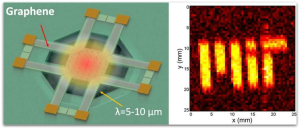Graphene is called the “wonder material” with good reason. The material hosts a slew of unique chemical and physical properties, with applications from fuel cells to biomedical to energy storage.
Now, a team from MIT is taking the material and applying it to infrared sensors to create next-gen night vision goggles. Additionally, the team is looking to take that same technology and apply it to high-tech windshields and smartphones.
We achieve night vision capabilities through thermal imaging that allows people to see otherwise invisible infrared rays that are shed as heat. This technology is useful for many different applications, such as assisting soldiers and firefighters in their duty. While night vision devices currently exist, they need bulky cooling systems to create a useful image.
Because of graphene’s electrical qualities, researchers have known that the material would be an excellent infrared detector. The team at MIT took this idea and moved forwarding in creating a less bulky night vision goggle through the utilization of graphene.
This from Popular Science:
These goggles rely on cryogenic cooling to reduce the amount of excess heat that might muddle the image. To create the sensor, the researchers integrated graphene with tiny silicon-based devices called MEMS. Then, they suspended this chip over an air pocket so that it picks up on incoming heat and eliminates the need for the cooling mechanisms found in other infrared-sensing devices. That signal is then transmitted to another part of the device that creates a visible image.

Image: Nano Letters
“The advantage of significantly reducing the cost and increasing the performance of infrared imagers is that now you can start introducing these cameras in many new places,” says Tomás Palacios, co-author of the study. “For example, in the future, we can have infrared detectors integrated in every cellphone and every laptop. That means that in the future, you can control them just by waving your hand in front of them.”
While the technology has tested successful, it is not quite yet ready to hit the market. Researchers hope to develop a device that can produce images with higher resolutions before moving forward.


